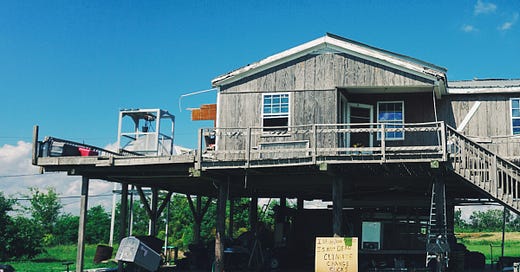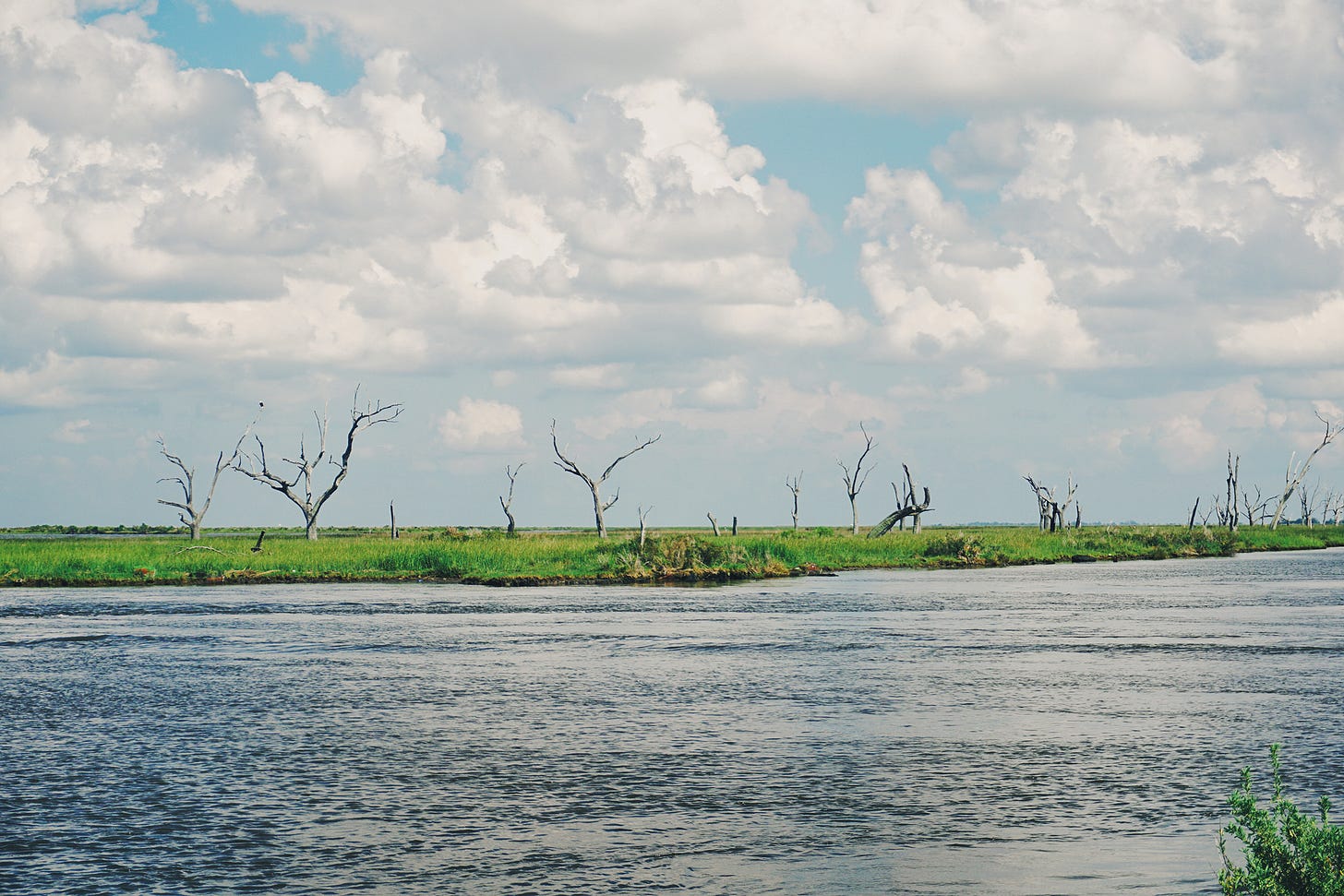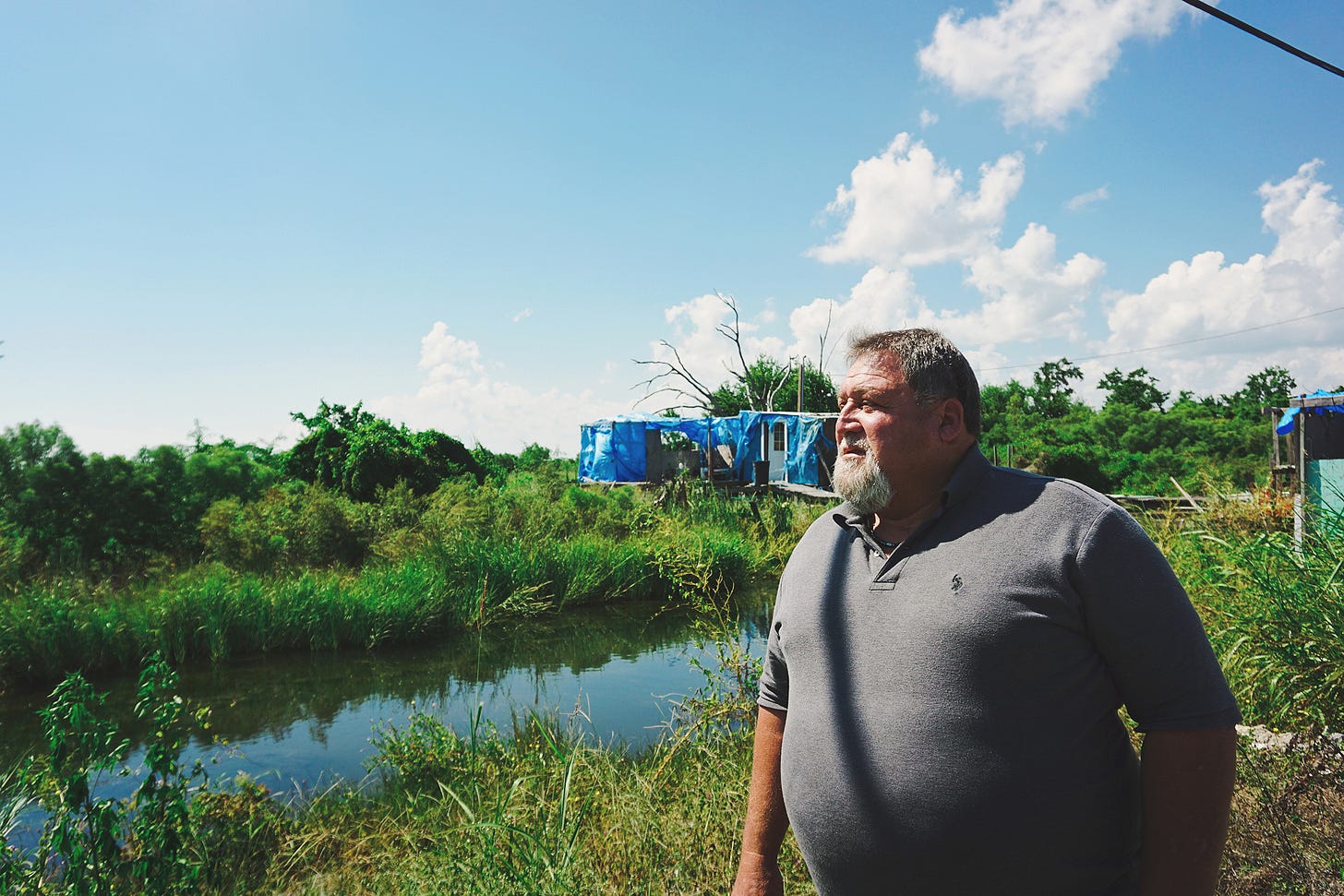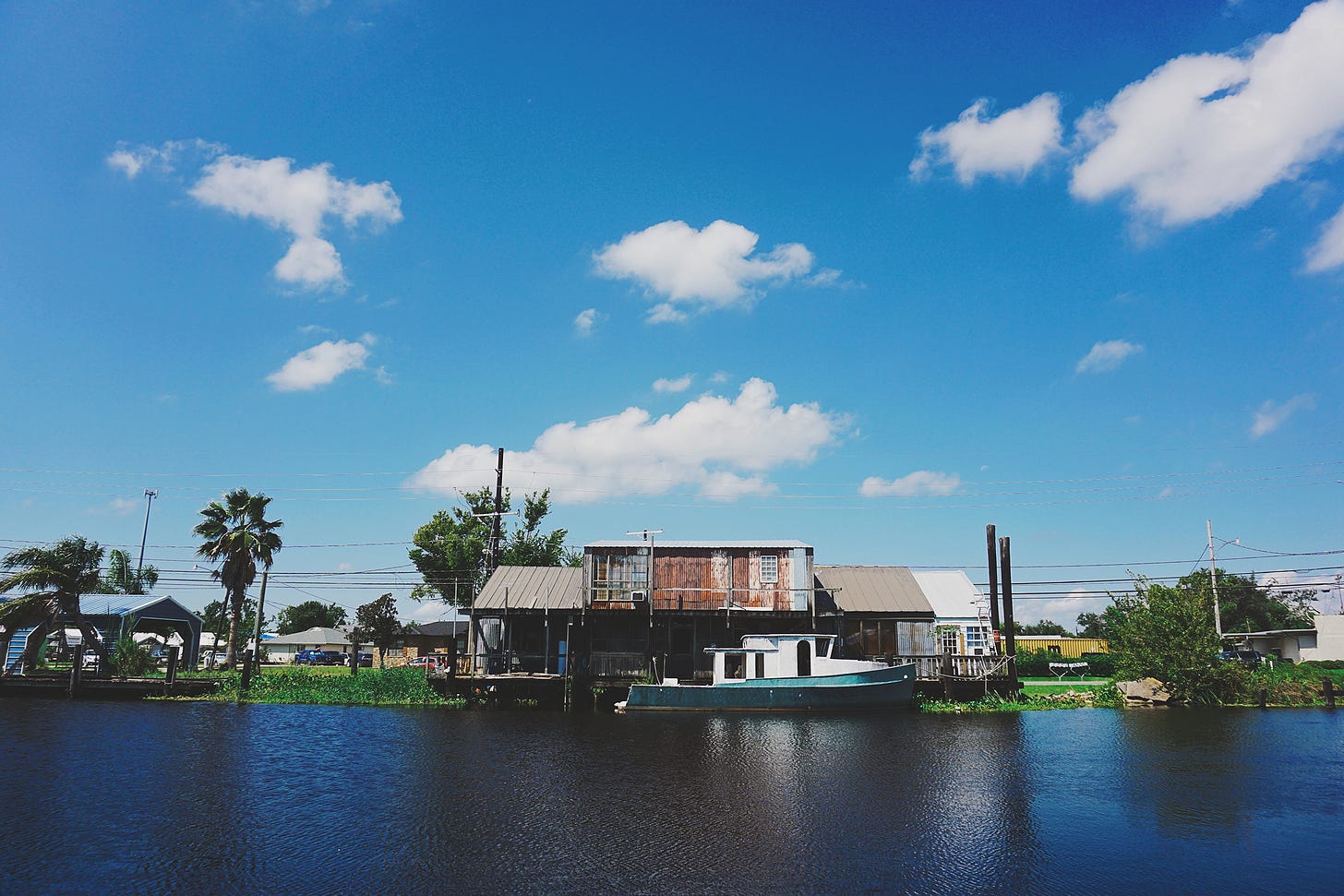Washing Away
Facing a vanishing coastline, members of the Jean Charles Choctaw Nation fight for their homes, family, and legacy
Editor’s note
Across the Tropics, I’ve encountered many communities losing land. In Puerto Rico, Seychelles, and the Philippines, to name a few, shorelines are being washed away by increasingly violent storms, forcing them to move inland to higher ground. But there are also communities across the U.S. mainland grappling with the impacts of climate change and vanishing coasts. California is the most recent state to be pummeled by brutal weather systems, and in the Louisiana Bayou, the Jean Charles Choctaw Nation has been watching their land slowly wash away for generations. I visited them this fall to record and archive their story for StoryCorps, and interviewed Chief Albert Naquin and his nephew JR, the incoming chief, among others. We drove across the island—now a largely abandoned, narrow strip of land—and saw the scars of 2021’s Hurricane Ida: houses reduced to stilts, a semi-truck half-submerged in the bayou’s waters. I was also introduced to smothered okra, a dish layered with history and made to sustain.
Here’s what I learned.
De corazón,
Von
The first members of the Jean Charles Choctaw Nation arrived on Isle de Jean Charles, Louisiana in the mid-1800s. Once known as the Biloxi-Chitimacha Choctaw tribe, they arrived on an island that was lush and abundant, a small ridge of land in the bayou dotted with oak trees, palmettos, and orange and grapefruit trees. Fleeing colonial persecution and displacement, many breaking off from the Trail of Tears, indigenous people settled on that island and ultimately formed a new tribe. There, they farmed and raised livestock, trapped and fished, and traded with one another for what they needed.
Chief Albert Naquin has been the Jean Charles tribe’s chief for 26 years and remembers growing up on the island in the 1950s. “We could go in anybody's house and get a drink of water or grab something to eat and then go out and play. It was like a big ole, happy family. People took care of each other.”
His nephew, Démé Naquin Jr., whose father preceded Albert as chief, also grew up on the island. “It was peaceful and quiet,” he remembered.
But over the years, a series of man-made interventions and natural disasters have chipped away at the delicate landscape. Oil pipeline canals introduced salt water into freshwater systems, damaging the ecosystem and killing trees. Hurricanes are common across the region, but in recent years climate change has increased the frequency and destructiveness of these storms, leading to flooding and coastal erosion and wrecking local infrastructure.
Ida made landfall as a Category 4 hurricane on August 29, 2021, leveling houses on the island and the surrounding cities of Montegut, Chauvin, and Houma.
“That's the worst hurricane that I've seen,” Chief Naquin said. “We realized that we was washing away.”
You can see that storm's wreckage today, and many who lack the resources to rebuild their homes still live in trailers.
Chief Naquin believes relocation is crucial for his community to keep them safe and preserve their history and culture. Since 2002 he’s made multiple attempts to acquire the funds and support needed to move the remaining families off of the island and reunite the tribe in a new community on higher ground. But his efforts have been stunted by numerous factors, including the inability to reach a consensus within their tribal council, and a planned move that was halted when community members in neighboring Bourg, Louisiana, protested the tribe's relocation there.
Most recently, the tribe worked with the state of Louisiana to apply for funds through the National Disaster Resilience competition, a 2014 initiative launched by President Obama. Because this contest was for federal state funds, they were not able to apply independently, but rather worked with state officials on a resettlement proposal that included homes, a community center, and green spaces, as well as retail and commercial businesses. Louisiana was awarded $48 million through this contest, but the funds did not go directly to the tribe. Instead, the state of Louisiana divided the recovery relief among communities surrounding Isle de Jean Charles, who also needed support, and so the tribe’s hopes for their new settlement—which they call New Isle— fell short.
So far, twelve families have moved to New Isle, with several more anticipating relocation by spring 2023. But government subsidies still fall short of the Jean Charles tribe's expectations and needs, leaving Chief Naquin and his people frustrated and vulnerable. He will continue his work to bring his community back together after years of struggle so that one day the tribe will be reunited as a family. One sign of hope: the tribe recently purchased four acres of land near Chief Albert’s home in Pointe Aux Chene, where they plan to have an office and develop the community space they’d hoped for in New Isle.
The above audio story originally aired September 23, 2022, on NPR’s Morning Edition.
Recipe From the Field: Smothered Okra
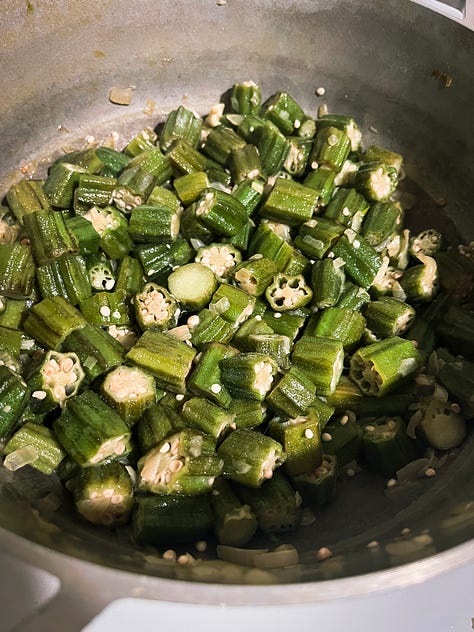
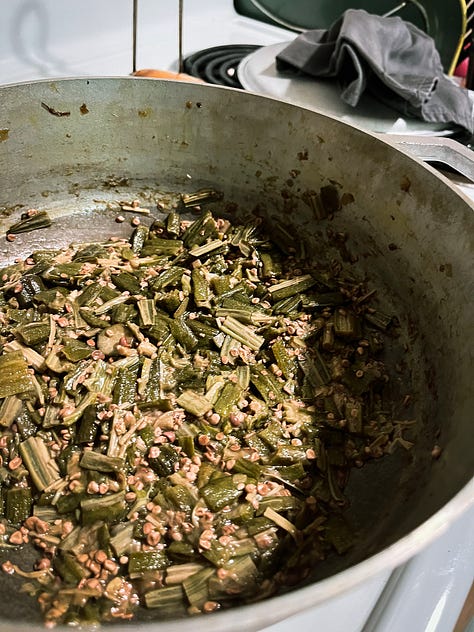
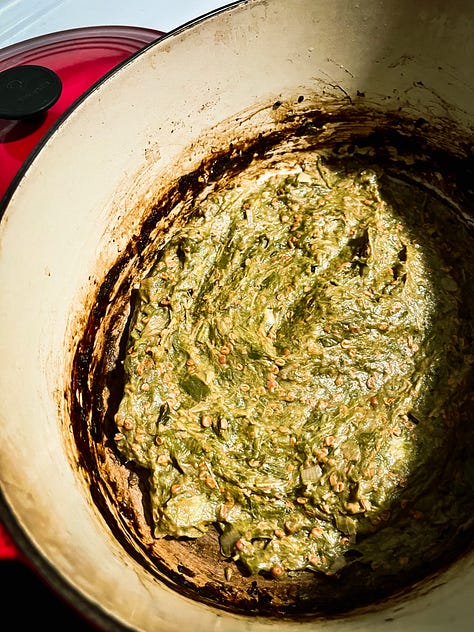
After visiting Isle de Jean Charles with JR Naqin, we stopped by the home of his friend and fellow tribal member, Alcee Dupre. That day, they were preparing to make gumbo, which always starts with smothered okra.
If I could choose one vegetable to grow at the end of the earth, it would be okra. It’s a beautiful plant, resistant to drought and high temperatures, and is among the few vegetables that contain protein. Across the Louisiana Bayou region, smothered okra is common, the slow-cooking process eliminating the controversial slime the vegetable produces. The result is a thick, velvety, creamy mash that can be used to thicken soups, stews, and, of course, gumbo. But folks make all kinds of things with it, adding peppers and tomatoes, sometimes sausage or shrimp, and serving it over rice or as a side.
Gumbo is undoubtedly among Louisiana’s most prized dishes, its history inextricably tied to the Transatlantic Slave Trade and the African people and ingredients forcibly brought to the U.S. Today, the dish is often made with a roux—a mixture of fat and flour combined to deepen the flavor and thicken—but okra was the original thickener. In fact, the word gumbo is a derivative of West African terms for okra. While I was not surprised to encounter this dish here, I didn’t expect that something with such distant ancestral roots could become a staple for this tribe. Although, upon reflection, both communities—enslaved African and Native American—struggled at the hands of colonizers and white slave owners, creating a bond that is too often underexplored. I spoke to JR about how he cooks okra; this recipe is my adaptation.
What you’ll need:
Gather about 1 pound of okra (fresh or frozen), 1 yellow onion (any size), a few large garlic cloves, vegetable or olive oil, and salt. Grab your favorite pot with a lid—the one that never fails you—and its companion wooden spoon. Then, chop the okra, onion, and garlic separately.
How to make it:
Two common approaches are stovetop low and slow or in the oven with moderate stirring. Stovetop is more labor intensive but preferred by many, while preparing it in the oven can be more efficient. Whether made on the stovetop or in the oven, the dish will be creamy and olive green, only the okra seeds discernible in the ultra-thick slurry.
For the stovetop:
Heat a tablespoon or so of oil over medium heat, and sauté your onions until they’re translucent, about 3-5 minutes. Add the garlic and sauté for another minute or so, then add okra and salt and stir well. Reduce heat to medium-low, lid, and cook stirring frequently until it’s no longer slimy, about 3-4 hours; could be less, could be more.
For the Oven:
Heat your oven to 300 degrees, then combine okra, onion, garlic, oil, and salt in the pot. Stir well to combine, lid, then bake for 2-3 hours, stirring every 30 minutes or so, adding small amounts of water as needed to avoid okra sticking to the bottom. Smother until it’s no longer slimy, about 2-3 hours; could be less or more.
Writer: Von Diaz | Editor: Stephanie Rodriguez | Photo Curator: Cybelle Codish
Special thanks: Chief Albert and JR Naquin, Alcee and Noelia Dupre, Heather Stone, Zanna McKay, and Annie Russell
Food and climate change are central themes in our work, and an investigation that began with islands now spans communities in the U.S. impacted by severe weather events. Future editions of the newsletter include stories from my forthcoming cookbook Islas: A Celebration of Tropical Cooking (Chronicle Books 2023), and the provocative history of the pineapple.
Paid subscriptions increase our capacity for hiring researchers, writers, photographers, and recipe developers to contribute to this project, and ensures that the bulk of our content remains free and accessible. Thank you for joining us, and please consider sharing La Piña with the food and climate-curious people in your life.


